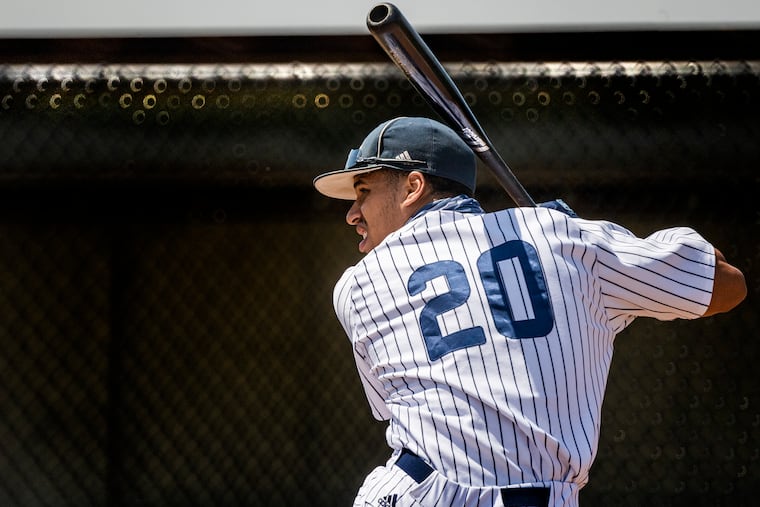Phillies scouting director Brian Barber sees plenty of high school talent and college pitching in the MLB draft
Recent 13th overall picks include Washington Nationals shortstop Trea Turner, and Miami Marlins pitcher Trevor Rogers.

In Baseball America’s annual ranking of prospects in a Phillies farm system that Bryce Harper recently panned as “depleted,” three of the top four players are pitchers. Is it safe to assume, then, that the club will select a position player Sunday night with the (lucky?) No. 13 overall pick in the MLB draft?
Don’t be so sure.
“I don’t think necessarily where the minor-league system is, or especially where the talent is in the big leagues, makes you take who you take in the draft,” Phillies amateur scouting director Brian Barber said Thursday. “The baseball draft is just so different than the football draft or the basketball draft, where they have a need immediately. We know we’re always working two, three, four years into the future, so where that talent is at the big leagues or the minor leagues can change year to year.
“So I don’t think you draft based on that current need.”
» READ MORE: Phillies amateur scouting director Brian Barber brings 'impressive' credentials into draft room
Indeed, the climb through the minors can take a while. Among recent 13th overall picks, Miami Marlins lefty Trevor Rogers (2017) and Boston Red Sox outfielder Hunter Renfroe (2013) didn’t make their major-league debuts for three years after getting drafted. It took New York Mets center fielder Brandon Nimmo (2011) five years. Shortstop Trea Turner made it to the big leagues in only 14 months but not before getting traded from San Diego to Washington.
The point is, Barber and his band of scouts will take a longer-term approach to the draft. But they also must add talent to a farm system that is generally considered to be near the bottom in baseball.
This will mark Barber’s second draft after being hired away from the New York Yankees. Last year, when the Phillies selected Oregon high school right-hander Mick Abel with the 15th overall pick, the draft was shortened to five rounds from 40 in 2019 because of the pandemic.
There will be 20 rounds this year, and Barber said the pool of players is deep with high school talent and college pitching. Barber doesn’t discuss specific players before the draft to avoid tipping the Phillies’ hand. But he noted the unusual volume of prospects in the Northeast, including Malvern Prep outfielder Lonnie White Jr., Bishop Eustace Prep lefty Anthony Solometo, and Mainland High right-hander Chase Petty.
“The amount of talent that’s [in the Northeast] is at an unprecedented level of what it normally is,” Barber said. “I spent way more time here than ever in the past, and every scouting department did as well. Why? I’m not 100 percent sure. But it is a great year, talent-wise. It was every bit as talented in the Northeast as it was in Florida or Texas or California this year.”
Baseball America has linked the Phillies to several players, including outfielder Benny Montgomery from Red Land High School in York County, Pa. Others who have been floated as the Phillies’ pick: Right-handers Andrew Painter from Calvary Christian Academy in Fort Lauderdale, Fla., and Gunnar Hoglund from the University of Mississippi.
“There’s a lot of talent out there,” Barber said. “The amount of really talented high school players out there is at a super-high level this year. There’s a lot of pitching out there, all throughout the country, both on the high school and the college level. It’s going to be strong. There are going to be good players, players that we’re excited about come the 20th round as well.”
» READ MORE: Draft-worthy baseball talent is teeming in our region. Technological year-round training is the reason.
Regardless of which players they select, they will have had ample opportunity to see them in person.
Last year, after high school and college seasons were canceled, teams had to rely on videoscouting and archived scouting reports. But Barber said they were cleared to send a limited number of scouts to events beginning last summer and fall. The Phillies also continued to use Zoom, live streaming, and other video technology to enhance their information gathering.
“It just allowed us to be able to meet more players than you ever would,” Barber said. “We started doing that last year and had meetings with almost 200 players, and that continued more and more. We’re at the point now that we can actually meet some of these players in person, and that’s always a good thing. But we used [video] to our advantage last year based on need, and this year it helped us.”
Barber is also working for the first time with Dave Dombrowski, who took over last December as the Phillies’ president of baseball operations. He said Dombrowski has sat in on “just about every meeting” since the team’s scouts came together at Citizens Bank Park and believes they are like-minded in the qualities they like in players.
“He’s been a great sounding board for me to be able to turn to, whether it’s during some of the meetings or even afterward,” Barber said. “I haven’t been around the game as many years as Dave has, but some of the conversations that we’ve had have tended to end in agreement a lot more than disagreement.”